Rousing is a behavior I’d never before photographed in either kinglet species.
Note: If you want to get technical (and maybe I should have been more precise and accurate) the term “rousing” only applies to raptors. The same behavior/action is called “settling” in other birds, including kinglets. When I first learned about rousing I thought it applied to all birds and for me it’s been a difficult habit to “shake” (sorry about the bad pun.). Personally I don’t see the need for the distinction so perhaps someone can explain that to me…
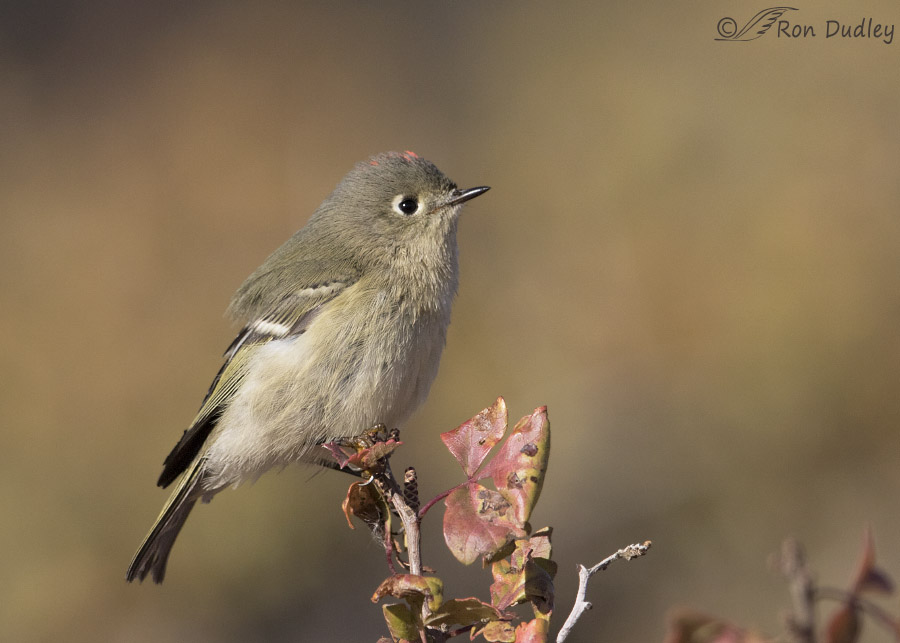
1/6400, f/6.3, ISO 800, Canon 7D Mark II, Canon EF 500mm f/4L IS II USM + EF 1.4 III Extender, not baited, set up or called in
About a month ago in remote Box Elder County this Ruby-crowned Kinglet was unusually cooperative. Not only did it pose for me on an appealing scrub oak perch with a mostly clean background and in good light but it did so for a fairly extended amount of time, especially for a kinglet. Throw in the interesting rousing (settling) behavior and some fairly good looks at its ruby crown and I couldn’t be happier.
I seldom see much if any of that ruby crown. It’s usually kept hidden unless the bird is agitated and that happens most often during the breeding season. But their nests, usually in conifers, average about 50′ off the ground so I rarely see these birds while they’re nesting. Usually I see kinglets during migration when their scarlet crown is revealed much less often so I was delighted when this bird gave me several fairly good looks at it (the best look at the crown is in an upcoming photo).
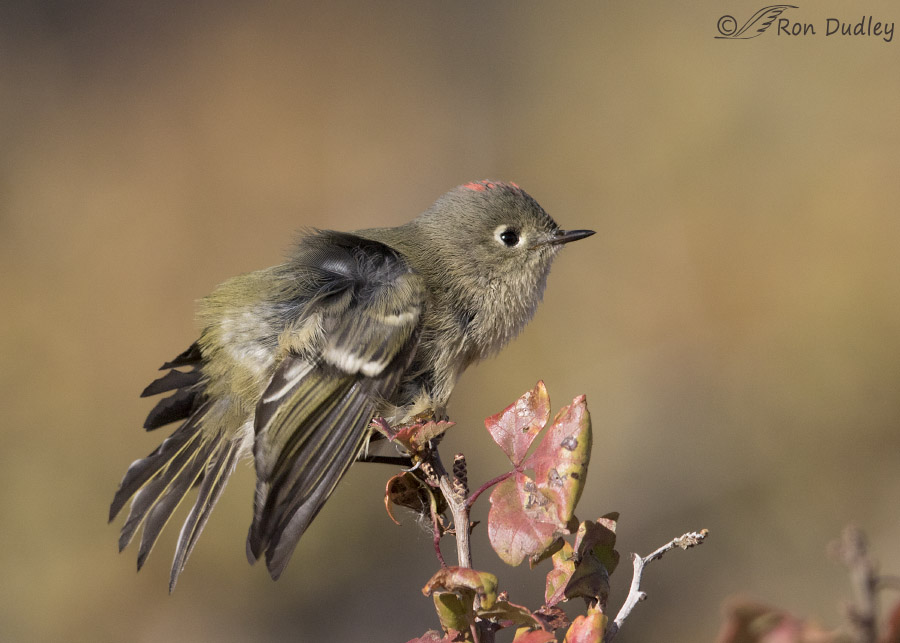
1/6400, f/6.3, ISO 800, Canon 7D Mark II, Canon EF 500mm f/4L IS II USM + EF 1.4 III Extender, not baited, set up or called in
Rousing is a common grooming behavior of birds where they erect their feathers and shake them so they’ll fall comfortably into place again. It also shakes out any debris in their feathers and when they do it it’s usually a sign of a relaxed and contented bird. In my experience with kinglets they’re seldom relaxed or contented so photographing this behavior was a real treat for me.
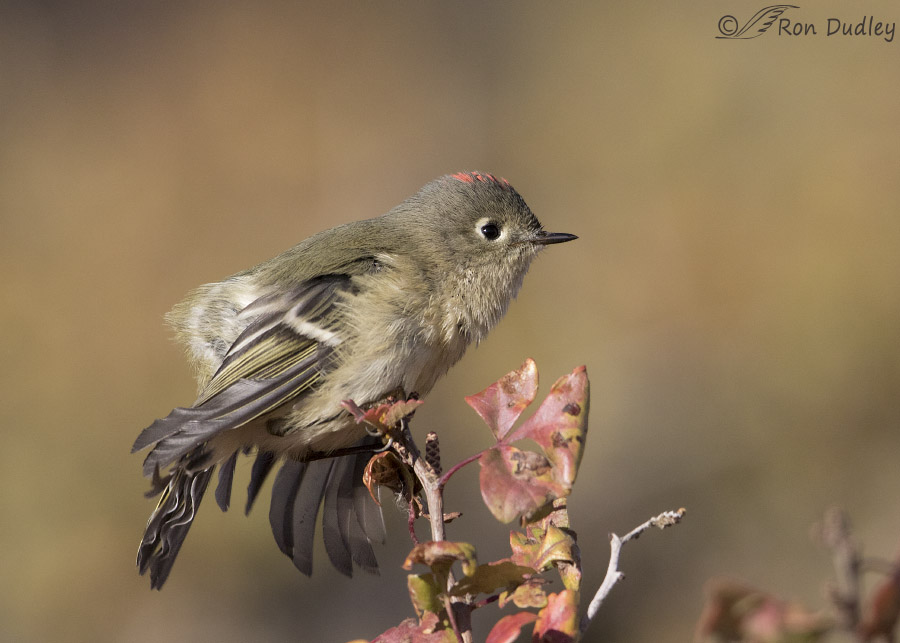
1/6400, f/6.3, ISO 800, Canon 7D Mark II, Canon EF 500mm f/4L IS II USM + EF 1.4 III Extender, not baited, set up or called in
By necessity feathers move very fast during rousing in any species but the smaller the bird the faster they tend to move. Kinglets are tiny so during rousing their plumage moves at blinding speed and this was another one of those times when my exceptionally fast shutter speed paid off because there’s very little motion blur, even in the flight feathers. Those ripples in the tail feathers are an indication of just how fast they were actually moving. I love that little detail.
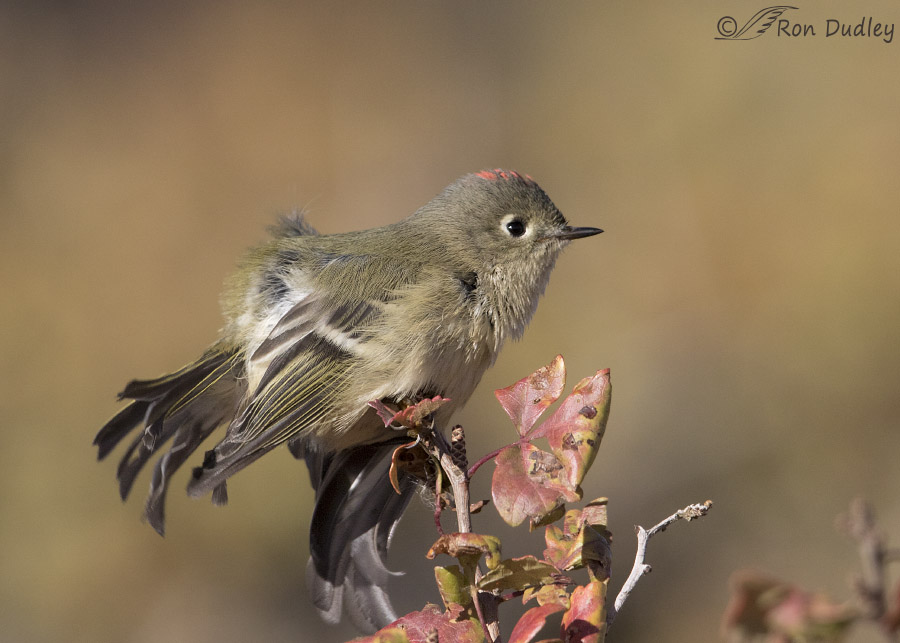
1/6400, f/6.3, ISO 800, Canon 7D Mark II, Canon EF 500mm f/4L IS II USM + EF 1.4 III Extender, not baited, set up or called in
While processing this last rousing shot I made a mistake. Can you spot it?
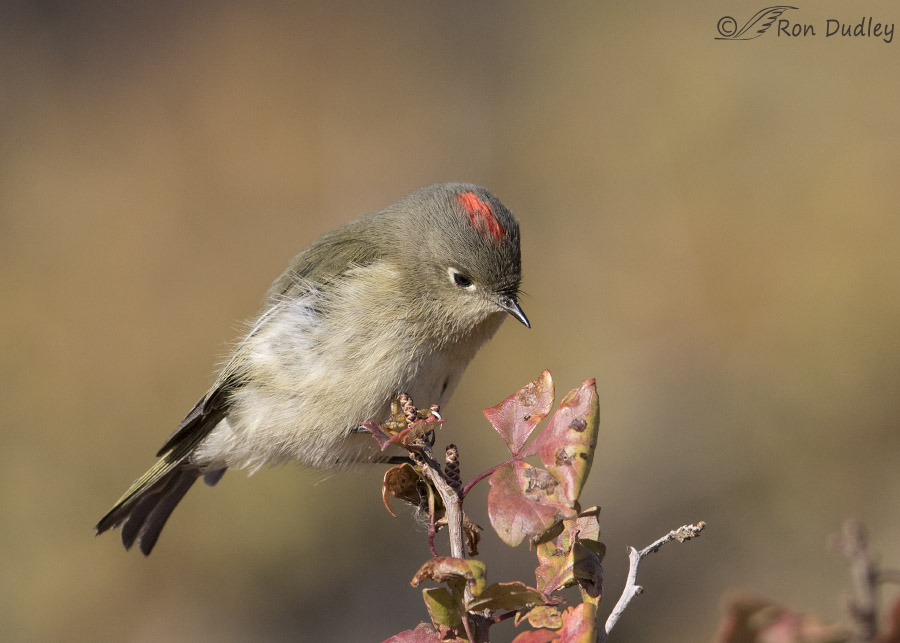
1/5000, f/6.3, ISO 800, Canon 7D Mark II, Canon EF 500mm f/4L IS II USM + EF 1.4 III Extender, not baited, set up or called in
A second or so after the rouse was over the kinglet even dipped its head to give me a much better look at that ruby crown. Because of the head angle I didn’t get any light in the eye but that’s a tradeoff I’ll gladly make in this situation.
In all five of these photos the ruby crown is only revealed instead of raised or erected. When its erected it’s a spectacular sight to see and I’ve observed a flash of it raised a time or two but so far that image has always eluded my camera.
Maybe some day…
Ron


Oh for pity’s sake! What a glorious series! It’s so difficult to image how these little jewels survive the harsh winters, and yet, they do. What a sheer DELIGHT it is to see them when you can. I’ve never caught the ruby crown in real life, but I’ll keep trying!
THANK YOU!
BEAUTIFUL photos Ron…love every one! Nicest Ruby-crowned Kinglet photos I’ve seen!
Thanks very much, Pamela.
MAGICAL series, Ron! Red crowns, rippling feathers, clipped wings, groaner puns, and all. 😀
Ha, at least someone appreciated my crappy pun. Thanks Marty.
I have gone back several times to look at the ‘ripples’.
Yet another delightful series. I hope someone can explain the rousing/settling issue. This word nerd would like to know.
Megathanks.
My guess is that someone’s feathers got ruffled. 😉
I just don’t understand why a separate term is needed just for the behavior in raptors, EC. On the surface I see no need for it.
Perhaps it was a raptor tha coined the term. I am sure Laura would tell you (and she has been told) that raptors ARE special, and special terminology is their right.
I’ve been hoping that Laura would jump in on this. But she said recently that she’s been cleaning house… 🙂
Hey guys…sorry, this cold got me and I slept the day away yesterday. Added to the degree of difficulty getting through my emails (each takes about 30 seconds to delete and sometimes I just don’t have that much patience…LOL), and there we were.
As another word nerd, I don’t know with 100% certainty, HOWEVER, I would guess that the difference arises from the SPECIAL, separate, ancient and now-arcane language that arose out of falconry. There are all kinds of words, specific to falconry. Some have survived to today (old hag, old codger, boozer/bouser and several others) although with a little morhphing here and there. Most have not. For example, what would you guess “funking the bank” to mean? It’s when the bird (falcon/hawk) is perched on the edge or lip of its bath pan, generally contemplating life before jumping in to bathe. Snite is a sneeze in ancient falconry language. I would guess that rouse is one of those words reserved only for raptors, just because they’ve been considered special for multiple centuries. But that’s just a guess–albeit a SWAG (Scientific Wild A$$ed Guess). 🙂
I love words!
Marvelous series Ron!
Charlotte
Thanks, Charlotte.
Another great series of a charming little bird that I’d love to come across more often in my travels. Thank you!
I’m glad you enjoyed it, Joanne. Thanks.
The colors are lovely, and what a Ruby Red crown, does almost look like sunlight hitting head or reflecting light. Well you did not get a catch light in the eye, but you mentioned that already, and the picture not centered? Wing cut off and soft? Any way what ever you did wrong does not matter to me. Very pretty with red colors in the leaves.
Bingo, you win the cigar, Trudy! Hope you enjoy it but dang those things stink! 🙂
Yes, I cut off the virtual tip of the left wing in that photo. It’s referred to as “virtual” in these situations because even though the tip is hidden we know where it is and I didn’t leave enough room for it.
It’s a processing mistake because I didn’t cut it off in the original photo, I actually had plenty of room down there. I cut it off when I cropped the image which was pretty dumb.
I was once “dinged” for doing the same thing to a Barn Owl image I posted to a photo critique forum years ago. Silly of me to make the same mistake again. There’s an explanation of that original mistake in the following link if anyone’s interested.
https://www.featheredphotography.com/blog/2013/01/31/a-tale-of-a-barn-owl-tail/
Hi Ron,
No need to say you’re sorry – IMHO, there is no such thing as a “bad” pun…😀
Cheers,
Dick
Sometimes I just can’t resist them, Dick – bad or not…
This is an amazing series of shots. These birds don’t sit still for more than a second or so at a time. On the shot with the “mistake” I notice softness in some of the feathers, but that’s all. I’m glad you and your camera were able to catch this bird so well, to give us an otherwise not possible way to get better acquainted with it.
Thank you, Susan. Yes, some of the feathers are softer in that shot but that’s not the mistake I was referring to. If no one spots it soon I’ll provide a hint…
One of my most favorite birds! <3
🙂
Great shots as usual and my question I don’t think has anything to do with your mistake, just I don’t understand what is going on. I like all the shots, but please explain to me what is going on in picture 4 with the left wing? Picture 3 I understand, but picture 4 is a mystery relative to what is happening under the bird?
Dick, in that 4th shot the shaking action has apparently caused some of the darker-colored interior secondaries to cross over in front of the lighter-colored and longer secondaries at the end of the wing. During shaking the different lengths of those feathers caused the two groups of feathers to move differing amounts and at differing speeds into unusual relative positions.
At least that’s my best guess…
Thanks for the explanation – makes sense.
Wow– even a peek at the edge of his crown in profile–looks like the last glowing embers of a fire……
I like your analogy, Kris.
Love this series, they are such cute little birds Especially like the last for the glimpse of the ruby crest and the angle of the bird…the colors are beautiful.
I’m glad you like the series, Patty. Thanks.
Just getting an unobstructed photo of a Ruby-crowned Kinglet in focus is challenging enough! These are fabulous!
You’re sure right about that, David. I went many years before it ever happened for me with this species. Thank you.
Beautiful – it’s like “paint” was dropped on it’s head to match the foliage….:) All I notice is it’s a bit less sharp which may or may not have to do with processing! 🙂
Good eye about the relative softness Judy – that was due partially to depth of field and to the fact that that shot was apparently taken when the feathers were moving fastest.
The “mistake” I was referring to is something else…
Will have to wait for the “experts” I guess 🙂
Beautiful series! Thanks for sharing.
Thank you, Elmer.